La Ciudad Y Los Perros - The Time Of The Hero
Saturday, September 30, 2006
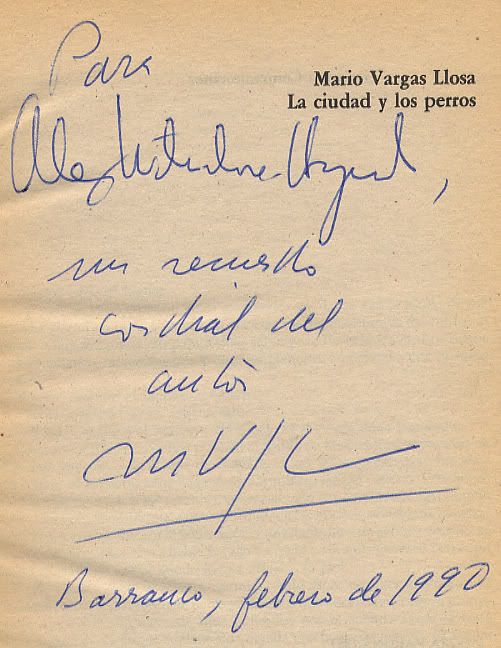

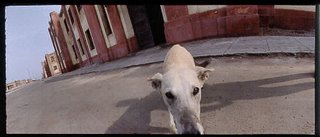
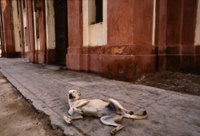

Mario Vargas Llosa's first novel, published in 1962, La Ciudad y los Perros, translates as the City and the Dogs but its 1966 translation into English became the more romantic The Time of the Hero.
The novel is an autobiographic account of Vargas Llosa's stay as a young boarder in the Leoncio Prado Military Academy in Callao (Lima's port). This novel was so critical of the military academy that the Peruvian military burned 1000 copies of it when it was published.
But in 1990, When I went to Peru to interview and photograph the author, who was running for the presidency, his name was sufficient to get me into any building, school or institution mentioned in any of his essays and novels.
By 1990 I had managed to read all of Llosa's output to that date and I had been particularly affected by a short story, Los Cachorros or The Cubs with disturbing happenings in a private school. A young man loses his private parts to a dog that attacks him in the shower. How this young man grows up in a Latin American macho society is the fascination of this short story that was later made into a movie in Mexico.
So when I arrived at the Leoncio Prado Military Academy I was almost shocked by the dog that greeted me at the entrance. It was the South American summer vacation so the school was empty and eerily quiet, except for a whistle from the almost constant wind from the Pacific, a few yards away. I photographed the almost elegant dog and went through the school which was exactly as described in the book. The bunk beds were there as were the empty lockers.
When I told Vargas Llosa about my visit I first realized that curious reticence by novelists to acknowledge or admit that any place (even when named) in one of their novels could actually exist. When I located the famous ice cream store central to the plot of La Historia de Mayta (1984), English translation (1986)The Real Life of Alejandro Mayta, the man was visibly anoyed.
Mario Vargas Llosa
Of Daturas, Brugmansias and Floripondios
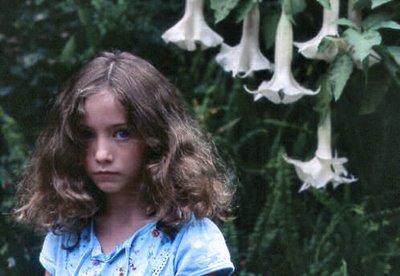
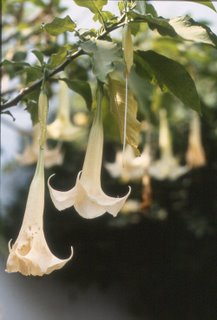
There is much confusion on these two closely related plants, the Datura and the Brugmansia. It's simpler to think about it in Spanish. In February, 2000 I was in Mario Vargas Llosa's garden in Barranco, a neighbourhood of Lima, Peru. I had never seen this little tree in my life (right, the floripondio in Vargas Llosa's garden). I asked Vargas Llosa for its name. "Es un floripondio," he told me. The plant is from the tomato family and it is supposed to be either deadly or halucenogenic, or both. That a young man died in the BC interior after ingesting (he wandered quite confused for a while)a native BC datura might confirm that indeed it is deadly.
A various times of the day and particularly during warm and humid nights the several floripondios that grew in our Morelia hotel last August spread the sweetest perfume imaginable. I photographed Rebecca by one which was a double form.
Floripondios
The Salesian Nuns & The Priest
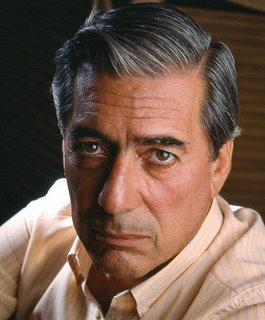
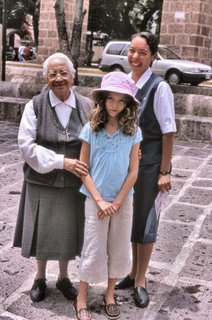
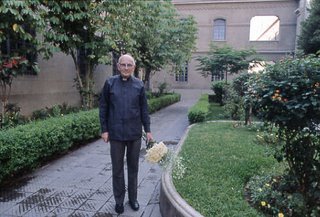
We were sitting on a stone bench by the imposing aqueduct in Morelia, Michoacán in Mexico last August, when these two nuns passed by. To see a nun almost dressed like a nun in Mexico is a treat since in the 60s and before, nuns, brothers and priests could not wear anything but civilian attire on the streets. I stopped them and asked them from what order they were. They told me they were from the Salesians, originally from Italy. They posed with Rebecca and I asked the older nun to bless her.
As they walked away I remembered a Salesian priest I had photographed back in 1990 in La Escuela de los Salesianos, a Catholic school in Lima where Mario Vargas Llosa had gone as a young boy. I had asked Padre Francisco if he could tell me anything about the novelist who was soon to be president. He was very diplomatic and unforthcoming, "He was a good boy." He turned around and walked away with his bunch of flowers.
The soon-to-be president wasn't. One morning , the morning he returned from campaigning in Piura, he was very sick. Piura is a city in Northern Peru which was the first city in Peru, founded by Francisco Pizarro in 1532. Llosa had eaten a ceviche that had given him stomach poisoning. He was in pain when he posed for me. That evening he was to give a talk at the Japanese Peruvian Club. I went to it but he stayed home. The Japanese/Peruvian community felt ignored. The rest is history as Fujimori came from nowhere and won the election. For those of us who love his books this has meant that Vargas Llosas literary output was never interrupted.
For me Vargas Llosa's loss was a bittersweet experience. I love his books but I will never know what would have happened if Condé Nast Traveller had published my essay and photographs, Mario Vargas Llosa's Lima. It all hinged, the travel editor told me, "If he wins."
ultra-brite Mexico - Hawaii
Friday, September 29, 2006



It was over 35 years ago that I was teaching English to Colgate Palmolive executives in Mexico City. We were discussing our perception of colour. This bunch spoke quite well and many of them were from the marketing department. It had all started when one of my students raised the subject of what could be wrong with the marketing of ultra-brite their latest tootpaste at the time.
I really liked it. Somehow Colgate Palmolive had circumvented the Mexican health regulations and this product had ether. When you brushed your teeth if felt like you had foaming and tingling ice water in your mouth. I loved it. But I had my suspicions on why Mexicans avoided buying it. I asked my class how they liked the combination of dark blue, gray and white as compared to red, orange, pink, yellow and white. The class agreed that the former cool colour combination was not to their liking. I then pointed out that the cool colours were those of the ultra-brite boxes while the others of the competing and better selling Crest.
While globalization is now helping (or hindering) the personal colour tastes of nations we came to the conclusion then in that Colgate Palmolive class that Mexicans liked hot reds while nations further away from the equator tended to like cooler colours like blues and greens. At the time Mexico City traffic was a Technicolor display of red and yellow. The green mountains of the rainy season changed to rich browns and ochres in the winter. The colour of the light in Mexico City (filtered by pollution) was warm. People in the street wore bright coloured clothing. Vendors sold sliced oranges or corn on the cob with liberal sprinkling of red chili powder.
In Vancouver, by early August when I look at the North Shore Mountains I can already see the cyan in the blue of the sky. Cyan is a cold colour. To me it is our "winter blue". It depresses me. By November Vancouver is green, blue and gray. By January, those who can, go to Hawaii. Those of us that can't, make do with Art Bergman's ultimate Vancouver song, Hawaii:
Let's go to fucking Hawaii
Get down in the sun
I want to lay on Wakiki
Get a tan on my bun
Running from the rain, thousands on the run.
Perhaps I have lived too long in Vancouver and I have lost my memory for the hot colours of Mexico. This August I spent hours shooting blue agaves in Michoacán, Mexico.
I miss my ultra-brite and those reds, those ochres....
Horseless Carriages & Digital Wonders
Thursday, September 28, 2006
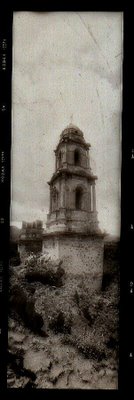
Not too long ago I got into one of those senseless arguments about film versus digital. These arguments are no different from religious or political ones. None of the participants will give ground and the argument will end in shouts, flaming and insults. But this time I was into something. The guy on the digital end said my scans of my original transparencies (large slides) and negatives were poor imitations of the real thing.
I thought about "the real thing". I got back to him by saying that in reference to my slides and negatives, I could burn them, twist them, project them, print them, even ignore them in a shoe box and if I wanted to I could even chew on them. "Where is your original? Is it a series of 1s and 0s inside a memory card? Can you touch and chew those 1s and 0s?" The guy on the digital end had no way of refuting this and the argument ended in my "victory".
Photography is in a hard to predict transition. Those who shoot digital are out to prove how their digital cameras can mimic film and print large images and ask you to guess if they are digital or photographic prints. This is senseless. What would you think of a person driving a horseless carriage that could deposit stuff on the street every few blocks that looked just like horse droppings? What would we think if the horseless carriage were to spray your own vehicle with a steaming yellow liquid?
Digital photographers must look into the future for indication of where they are going and should leave us, who shoot film, in our past.
Of that past Roland Barthes wrote eloquently in his Camera Lucida - Reflections on Photography:
One day, quite some time ago, I happened on a photograph of Napoleon's younger brother, Jerome, taken in 1852. And I realized then, with an amazement I have not been able to lessen since: "I am looking into the eyes that looked at the Emperor." Sometimes I would mention this amazement, but since no one seemed to share it, nor even to understand it ( life consists of these little touches of solitude), I forgot about it.
That photographic past can sometimes crop up into our present. I took my Dresden made Noblex 175 to our Morelia, Michoacán, Mexico vacation in August. The camera, which has a swiveling wide angle lens, takes a picture that is 50mm by 175mm. The b+w negatives I took were too big for the 4x5 inch limitation of my scanner's negative/slide lightbox. I decided to place the negatives right on the scanner bed and placed a sheet of white paper on top. I scanned it and got a negative image. When I reversed the image (with Photoshop) the result was earie. It looked like a William Henry Fox Talbot, "Talbotype". These (taken in the 1840s) were paper prints made from paper negatives that were sandwiched on to sensitized paper to make a positive. Here you see the partially buried church of San Juan Parangaricutiro not too far from the Paricutin volcano that first erupted in 1943.
Doug Holtby - Broadcasting in the Bathroom
Wednesday, September 27, 2006
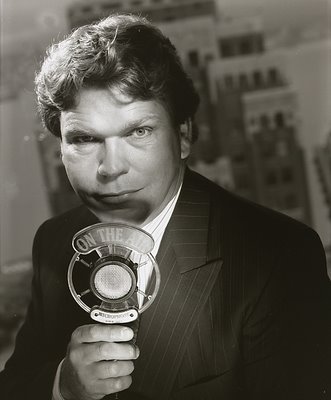
On Monday afternoon I went to Baseline Type and Graphics to okay the proof on my new busines card. I needed new ones to incorporate this web page and blog address. While walking on Robson I noticed a tall man with glasses outside the Telus building. It was 2:55 and he was leaning on a Georgia Straight dispenser. I went up to him and said, "You are Doug Holtby." He looked at me and said, "You have a long memory. Sometimes I am not sure myself if I am Doug Holtby." We chatted and I asked him why he was there. It seems that he is a consultant. Holtby, the former CEO of WIC West is an expert in broadcasting. Telus is trying to get into the game of bringing TV into our homes through a phone cable and even with wireless technology. Soon we will be able to watch that game on our cellular while being where even the king is alone.
Holtby asked me for my card! And of course I don't have any yet. At home I checked my files and this photo of the man I took in August 1990.
Las Serias - The Serious Ones
Tuesday, September 26, 2006
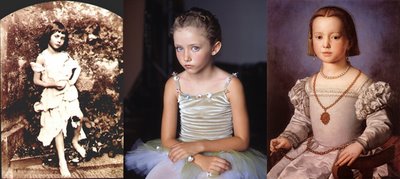
For a year I photographed my granddaughter Rebecca looking at the camera. I never asked her to smile. She never volunteered and that was fine with me. Rosemary (my wife) was troubled until I explained to her that perhaps Rebecca wanted to act like an adult or was simply giving me the face she thought was "adult" like. In this series you can see a photo of Alice Liddell on the left, taken by the Reverend Charles Dodgson. I believe that Dodgson, as Lewis Carroll, may have written his Alice books as a gift to a young girl that he saw as an adult. Perhaps in the 20th or 21st century Carroll would have been locked up. Much has been written how in Victorian England children were exploited in the workplace. They were seen as small adults. The photo in the centre is of Rebecca with her "adult" face. On the right is Bronzino's (1503-1572) portrait of Isabella de'Medici.
Today I had a little chat with Rebecca. I tried not to weigh her forever, as my mother did, when she told me, "Alex you have many flaws but you have one redeeming quality. You have integrity." I believe that I may even ask Rosemary ( if I don't suddenly die in a vaporizing explosion which would make it all so much easier!) that she inscribe on my tombstone, "He died with integrity." My mother's pronouncement has been a lead weight around my neck.
I told Rebecca that as lovely and talented as she might be she has one quality above all others. It is her ability to respond to logic. She is reasonable in the real sense of the meaning of that word. I asked her what was the possibility (we were driving in Sophie, Rosemary's car) that a meteorite might hit Sophie's roof and kills us on the way to Nikolai Maloff's piano lesson. Rebecca answered that it was possible but unlikely. I then told her that the study of the process of probability is called statistics. She then made that leap that surprised me, but somehow I statistically expected. She said, "This means that if I quit my piano today, I might start it up again later but statistically it is unlikely that I will." I wanted to scream, "Eureka," but I didn't.
Ayesha
Monday, September 25, 2006
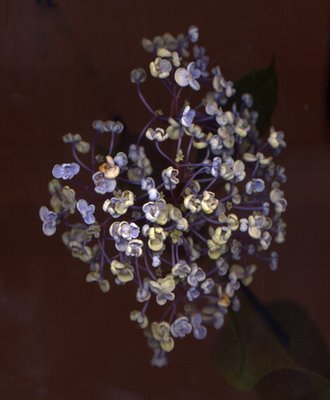
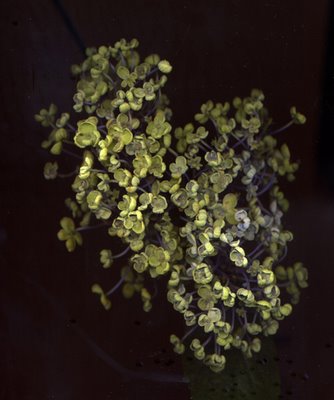
We are expected to notice and glorify the young and the perfect. We lust after shiny new cars - Porsche Boxters and try to prolong it all with Botox. Our wooden floors have been Varathaned to perfection. The idea of using special slippers (so as to not mark the old floor) when we visited Iolani Palace, the official residence of King Kalakaua and Queen Liliuokalani, in Honolulu, seems quaint now to me as I look into my garden and compare two separate mopheads from the same bush of my Hydrangea macrophylla 'Ayesha'. This mophead is so different from the others (I have over 35 varieties of hydrangea and 6 species) that I can agree with many who want to place this delicate plant in a separate species. The Ayesha, above left is a younger flower while the other bloomed earlier in the season and it is going green.
What makes hydrangeas so beautiful is the transformation from youth to old age. A human lifetime in one season is there for me to observe and enjoy. When I look at the old photographs of Rosemary and me from 40 years ago now, my nostalgia is modified by my understanding that beauty, like a hydrangea inflorescence, lasts much longer than I used to think.
Notes Of Compassion
Sunday, September 24, 2006
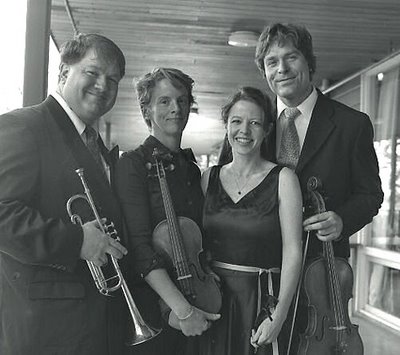
When I looked at my program of Notes of Compassion ( a volunteer collective of musicians from the VSO who played, without a conductor, yesterday as a benefit for Health Arts Society at Vancouver's George Pearson Centre), I knew I was going to need some Kleenex. After all there was Claude Debussy's Clair de Lune smack in the middle of the program! As I watched the over 200 concert goers, some on wheelchairs and with respirators, I noticed their smiles and I cried. But I wasn't prepared to cry twice and this is what I did when I listened to Kurt Attenberg's (worked for the Swedish patent office a job description that he shared with Albert Einstein who held the same job in Bern) Suite for Violin, Viola, and Strings, Op.19, No1. The violist, Andrew Brown explained how this suite inspired him as a young man to become a musician. The suite was lovely. Before the "crying pieces" I was jolted into attention by Frederick Shipizky's Aurora Fanfare which featured the VSO Brass Quintet. The wake up call that this was was followed by a spirited (as in nice and quick which is how I like it) performance of Bach's Brandenburg Concerto No. 3 in G Major. Notes of Compassion also played a very loud (that's how I like it!) couple of Dvorak's Slavonic Dances (Op. 46, No.s 1 and 8) and Haydn's Trumpet Concerto in E Flat Major.
It was the Haydn Concerto that made me think that the first time I had ever heard it live was with a conductor (a not yet Sir, Eliot Gardiner) and trumpet player Martin Berinbaum at the Orpheum with the CBC Vancouver Orchestra (as it was called then) perhaps in 1982 as my original program has no date. The version I heard yesterday featured a very warm but confident Larry Knopp. The folks at CBC Radio have a fondness for jolting me out of bed at 6:30 with this concerto. But mid afternoon it was perfect. I wonder what violinist Karen Gerbrecht( seen here with Larry Knopp, left, Rebecca Whitling violin, and Andrew Brown, right, viola) might have thought of Knopp's performance as her father Jerold Gerbrecht was the principal trumpet player for the VSO for many years. If it had not been for a timely communication from Rebecca Whitling, my non readhead ( Karen is a redhead!) favourite VSO violinist I would have never known about the concert.
A resident "spy" of the George Pearson Centre, and friend of mine, Maxine told me that the whole concert came together thanks to the persuasive influence of David Lemon who made a very short introductory speech. I noticed that Christopher Gaze was there and suddenly the perfect concert became a 99% one. Perfection would have been his interpretation (I have heard Gaze say it many times and I hope to hear it many more times!) of the St Crispin Day's Speech from William Shakespeare's Henry V. When I left for home there was one line from that speech that resonated in my head:
We few, we happy few, we band of brothers;
Somehow all who attended that concert could repeat those lines.
Paul Leisz - The Frugal Bus Driver
Saturday, September 23, 2006
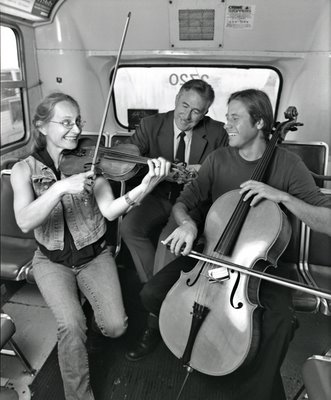

I married the first Canadian I met (Rosemary) in Mexico 40 years ago. When we came to Canada in 1975 I became friends with the second Canadian I met, Paul Leisz. Paul was born in Hungary and came here with his parents as a young boy. Paul has driven a bus for the last 20 years. 30 years ago Paul taught me the fine Canadian sport of sitting very near the woman's bathroom of the Fraser Arms pub. "They all have to pass by our table, sooner or later." Paul was also of that generation that owned a TR-6 which he drove every year to Penticton. Paul is frugal even though I have never heard Hungarians boast that they invented the bagpipes. His frugality has led him to finding ways of repairing anything and always finding the best deals. I have often profitted from his deals. My computer, which Paul supervises and nurses, has never crashed. Its record is as fine as his own bus driving record. For my first computer Paul took me to a small shop on Bridgeport road and we ordered my computer by components. If I am computer literate and still in this tough photo business I can only credit Paul for having pushed and dragged me into it so that I am competive today.
I have always been fascinated by trains and buses. One of the high moments of my life came when I was given a radio and the authority to stop a CP train (3 times) at the Sisco bridge near Lytton, BC. I felt as close to God as I have ever been! A couple of times I have felt as important and all because of Paul. One Christmas Eve many years ago Rosemary and I went to a corner store to buy some forgotten item for a Christmas dinner. As we left the store a trolley bus stopped right there and Paul emerged from the bus to give us a hug and he stayed and chatted.His passengers stared at us wondering who we were. On a second occasion I was crossing Seymour at Davie street when suddenly a trolley bus stopped while turning and Paul, again jumped out to greet me!
A bus driver has an intimate view and feel for our city and I am very lucky to know Paul so that he is able to share with me that unique view. The years have passed and I no longer play racquet ball with him. I stopped when a ball that Paul had driven went through my racket. I feared for my life. His visits over Earl Grey tea are more relaxing and satisfying.
On October 20th Paul and I are going to attend the West Coast Symphony's all Hungarian concert at Christ Church Cathedral. The conductor is Leslie Dala (right) my new Hungarian friend. Perhaps some day Leslie may give me the opportunity to start or stop an orchestra! Here you see Paul with the Vancouver Philharmonic Orchestra's Barbara Dominik and VPO and Westcoast Symphony's Byan Deans. The bus is a E-901 1982 series Flyer.
Hungarian concert
Sting, Little Mary, Message In a Bottle & The Bombshell Blond
Friday, September 22, 2006
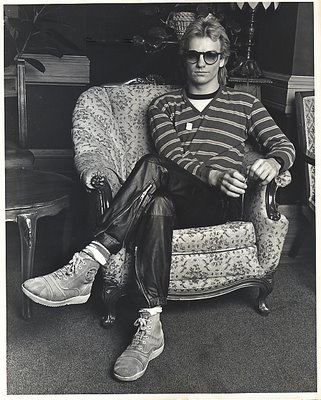
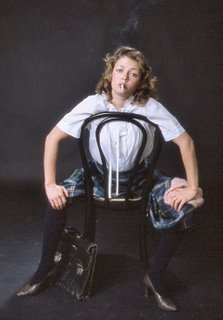
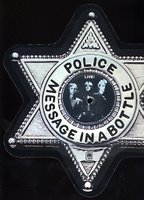
Last night I was talking to this bombshell blond who sports dramatic eyeliner at a Georgia Straight party on Granville Island. They were playing The Police's Message in a Bottle. I happened to mention that it was one of my all time favourite songs. It seems that at age 14, when BB (bombshell blond) first heard the song, she was lured away from mainstream music. Perhaps that song influenced her later sentimental decisions.
I remember the first time I ever heard that song. It was shortly after The Police album Regatta de Blanc was released in 1979. I was nursing a dry pear cider at the Number 5 Orange. The tiny 5ft tall dancer "Little Mary" had come down the lucite stairs from the ceiling dressing room to the sounds of Frank Sinatra. Little Mary looked around 16. Maybe she was 17. After the two Sinatra songs, everything was off and suddenly I heard Message in a Bottle. I kept humming it long after Mary went up the stairs. I enquired from Harry Brandolini (one of the proprietors of the joint) who Little Mary (above, left) was. It seemed that being short was a family tradition and Little Mary had a jockey brother. Little Mary, when not watched, could go through the bar's whole Grand Marnier stock in one day. I later found out that Little Mary could fill the Coliseum without a sound system. Her French was as foul as it could be. But then there was that smile and that fondness for Sinatra and The Police. Through the years I have kept in touch with Mary Arnold. When I last saw her she was designing and sewing fantastic costumes for modern dancer Cori Caulfield.
I photographed Sting for the first time in 1980. He told writer Les Wiseman and me that his band was going to be the next Beattles. We thought he was a pretentious Brit SOB. We were proven wrong.
Only hope can keep me together
Love can mend your life but
Love can break your heart
Message in a Bottle - The Police
BB, that 45rpm record on the right contains a rare live version. How about tea?
Lisa Milroy, Bette Davis & Stephen J. Cannell
Thursday, September 21, 2006
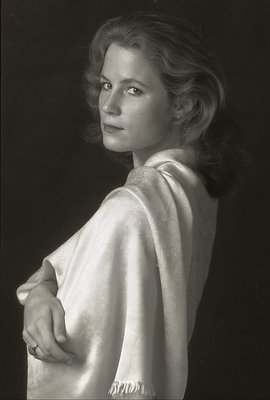
Sometime in 1982 I went to the Banff TV Film Festival. I had a job in the daily newspaper published during the week long festival. The job had been originally offered to still photographer Chris Halcermanas-Benge who had decided to stay in Vancouver to photograph Bette Davis during the making of A Piano For Mrs Cimino. Two events made that week memorable. I met Stephen J Cannell. In a seminar in which participants paid $150 for the honour (I went in for free) he told us that the three-act system is the only way a TV series will ever work. In act 1 you introduce the hero. In act 2 you bring in the conflict and the villain. Act 3 is the resolution. And that was that!
The other event of note was meeting one of the festival amanuensis. Her name was Lisa Milroy. She reminded me of a cross between Katherine Hepburn and Charlotte Rampling. When she spoke she sounded like Audrey Hepburn. I was charmed by her for a whole week. On the final night there was a formal (buffet) dinner at the Banff Springs Hotel. The men wore tuxedos (even I wore one) and the women beautiful evening gowns. I was lined up for the roast beef, juggling a very large and very hot empty plate. I heard that Hepburn voice. I turned around and behind me a radiant Lisa Milroy was wearing a pale green and very low cut gown. She was chatting with a friend (alas! there had been some vague rumours about this), a Frenchman who had directed and produced a film on Pier Paolo Pasolini. One of her straps had slipped and one of her breasts was completely exposed. Without thinking I moved my plate to her chest ( I didn't burn her nipple!) and I said (I swear it came out automatically),"A plate in time saves nine."
Back in Vancouver I photographed her in my Burnaby basement studio. Lisa moved to London to become a painter. That she is and she is also married to British art filmaker Paul Bush and has two children.
Xirau - Epicurus, The Streetcar & Columbus' Caravel
Wednesday, September 20, 2006
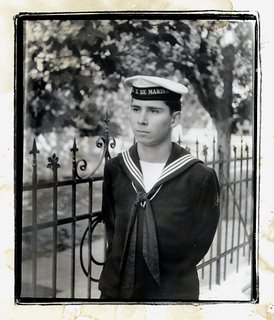
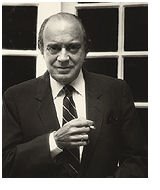
In 1964 I took my first university course in philosophy at the University of the Americas in Mexico City. My professor was Ramón Xirau Subias. I learned to love him for his passion, erudition and his gentleness. I attended almost two years of Xirau classes. He had come to Mexico in 1939 with his father, the Catalonian philosopher Joaquín Xirau Palau in exile from Franco's Spain. We had the unconfirmed story that deep in a philosophical conversation with his father, while walking on the street on April 10, 1946, they had not heard the clanging of the coming streetcar and Xirau père had died instantly.
While I was never Xirau's star student (that X is pronounced sh), my enthusiasm for the man helped me keep up and understand what he tried to expose us to. We would often have to interrupt him when he would start lighting his cigarettes from the filter side. His examination method consisted in giving us 10 questions a week in advance. On the day of the exam he would put 10 numbered papers in a box and someone in class would pick two.
Of all that he taught us, what most remained was his explanation on Epicurus and his concept of death. "Death," Epicurus wrote, "is nothing to us because at the moment we die—the instant we cease to exist—we experience nothing." Xirau then told us, "So you see, there is no reason to fear death." Looking into Xirau's smiling eyes when he said that, has left me with no doubt that when I see death in the face it will be Xirau.
With all that philosphy under my belt I decided that patriotism was important so I did not try to avoid the Argentine draft. After all, Socrates had happily served in the Greek army (they say to escape his shrewish Xanthippe). My "patriotism" was rewarded with a two-year stint in the Argentine Navy instead of a shorter year in the army. Philsophy did not help me through the ordeals of bootcamp. During a rest period, while I was reading Aldous Huxley's Mono y Esencia the corporal caught me. He yelled at me, "That little finger that sticks out while you read that useless book, you can stick it up your.... The only monkey here is you," and he tore my book to shreds. For days I had to do extra running and pushups. Bootcamp over, and with tears in my eyes, I lined up with my fellow sailors to swear allegiance to our flag and to protect our country's constitution. A few months later we were ordered to surround the Casa Rosada during a coup. The president, Arturo Illia, went home in a cab and the next day we had no constitution. "So much, for patriotism, "I thought. The first military decree, after eliminating the constitution and political parties was to specify the exact watts of light per square meter in Buenos Aires nightclubs (notorious for their lack of light)so that "our youth will not be led into base morals and at the same time be able to count their money."
The only way I could fight the military system I now loathed, was to refuse to have my hair cut or to plainly disobey orders. A rear admiral, one of my bosses, called me to his office and told me, "In war time I could have you shot. I could also send you to Antarctica where the only females you will see will be penguins. But since I need you to translate documents you will spend nights in the brig for a month and you will work here in my office. The first thing you will do is to go out, right now, and get a haircut."
I went to get my haircut and visited Pygmalion, the English bookstore on Corrientes Avenue. There I purchased, in preparation for my locked up nights,
1. The Philosophy of Hegel edited by Carl J. Friederich.
2. Markings by Dag Hammarskjöld translated by Leif Sjöberg and W.H. Auden.
3. The Philosophy of Man by Pierre Teilhard de Chardin
I can safely say that almost all of Hegel that went "in", rapidly went "out" undigested. Chardin impressed me in that he was a Jesuit who managed to write a whole book without mentioning God until the end. It was Hammarskjöld who has been with me always. When I try to imagine what he looks like he always looks like Xirau. My favourite quote from Markings is:
He was a member of the crew from Columbus' caravel - he
kept wondering whether he would get back to his home
village in time to succeed the old shoemaker before anybody
else could grab the job.
Ramón Xirau (82) is alive and well and living in Mexico City.
Evil At The Piano
Tuesday, September 19, 2006

I took Rebecca to her piano lesson with Nikolai Maloff yesterday afternoon. It was a tough class and Rebecca insisted that the piece she had to play was evil. She repeated this several times so that finally Nikolai (a very gentle man except when he attempts to demolish his piano during Beethoven piano concerto recitals) took her aside and told her, "This piece is not evil. Ask your parents the meaning of this word. Don't use it to describe our piano music."
I distinctly remember one time when I was around 6, when my mother was combing me that she said, "Alex, with your hair the way it is you look like Hitler." "Who's Hitler?" I asked. "He was a very bad man," she replied.
Outside I explained as best as I could that all humans have the capacity for being good or for being evil. I told her that most times our good side is in charge. I mentioned Hitler. "He was a bad man, wasn't he?" she asked me. "No," I replied, "He was a lot worse. He was evil." I proceeded to explain Auschwitz, the showers and zyklon B. When we arrived at her house she asked, "Did water come out of those showers?" I replied, "No." We didn't say anything more.
A couple of years ago I photographed Vancouver playwright Jonathan Teague (above). He had written a play featuring Hitler's SS. I remember telling Teague about the hair over my forehead when I was a little boy.
Angus Reid - The Man Who Never Was
Monday, September 18, 2006
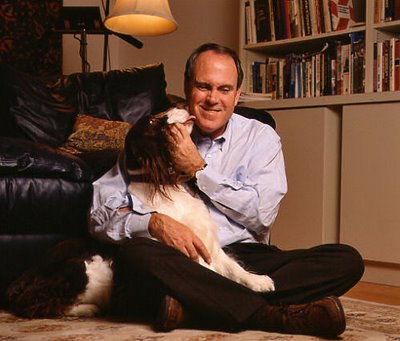
When Equity's de facto editor Mike Campbell called me up to ask me to photograph Angus Reid sometime in the early 90s I did not believe him. How could I photograph a poll company? I had never seen a photograph of this man that Campbell said existed. At the time Angus Reid was very careful to stay out of the news so that his company could do its job.
Mike Campbell and I showed up at Reid's West Vancouver home and I found two ways of taking pictures of the man who wasn't who suddenly was. I photographed him cooking in the kitchen and being licked by his dog. Both photographs had to be proof of Reid's existence. I remember that Campbell's conservatively loaded questions during the interview frustrated the liberal leaning Reid. Reid put an end to it by telling Campbell that he was not going to tell Campbell what Campbell wanted him (Reid) to tell him!
Recently I have seen many pictures of Angus Reid and I fondly recall that I was one of the first to photograph the man who never was.
Romeo & Juliet & The Harlot
Sunday, September 17, 2006
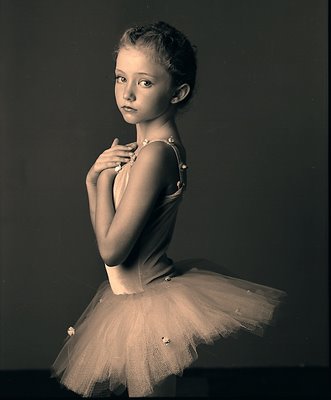

Perhaps 9 is some sort of rite of passage as I shared one yesterday with Rebecca.
I took her to Jean Grand-Maitre's Romeo and Juliet ballet performed by the Alberta Ballet & The Banff Centre at the Centre in Vancouver for Performing Arts. As I found myself explaining to Rebecca how Romeo had missed his cue about the fact that Juliet was not really dead and only seemed so, I remembered. I remember my mother taking me to see George Cukor's Romeo and Juliet with Leslie Howard (my mother's idol) and Norma Shearer when I was 9. She too had explained the intricacies of Shakespeare's plot.
Around 1994 I saw the perfect Romeo and Juliet, one day after a not so perfect one. I had gone to watch Evelyn Hart and her Royal Winnipeg Ballet at the Queen Elizabeth only to find out that since Evelyn Hart's partner was down with the flu she was not dancing either. I stormed out of the theatre and demanded my money back. My demand was rejected and when I was a couple of blocks away I remembered, "Alex, the music. It's live and it is Sergei Prokofiev." I returned to a thoroughly entertaining performance without Evelyn Hart. A publicist called me in the evening and offered me a ticket to next day's performance where she all but guaranteed that Hart would perform. And of course it was perfect.
I loved Jean Grand-Maitre's version of the classic. I loved all the magnificent sword fights and I specially liked Mercutio's taunting of Tybalt with a funny homosexual overtone. Juliet was no Evelyn Hart but she was very young, very blond, very beautiful and very believable as a young girl that Romeo would fall for. Her dancing was exquisite. When things got more complicated this Juliet, Leigh Allardyce, grew up convincingly. Jonathan Renna (who told us he had butterflies since it was his first Vancouver performance) was perfect for Romeo. Rebecca fell for him, so that was enough for me. And of course there was that live Prokofiev by the Vancouver Symphony.
We finished our day with a whipping cream and strawberries crepe at a Robson Street creperie with Sandrine Cassini (one of her multiple parts in the performance was that of a harlot and I had a bit of problem explaining that to Rebecca). With us were two other Alberta Ballet dancers. I enjoyed listening to Rebecca chat with Sandrine. Rebecca told her about her new jazz dance teacher, Ballet BC's Edmund Kilpatrick (seen here with Sandrine in her Carmen role).
But as we walked on Robson on our way home, the best was yet to come. "Papi," Rebecca said, "You were the only one at the table who wasn't a dancer."
A Perfect Day With W.P. Kinsella
Saturday, September 16, 2006
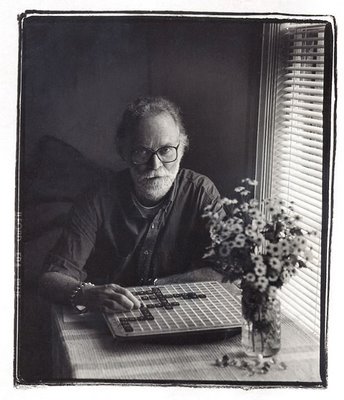
On June 18, 1999 I drove to Abbotsford to photograph W.P. Kinsella for Saturday Night. In previous shoots Kinsella had been really nasty to me so I didn't look forward to it. But this time around he was courteous and pleasant and gave me lots of time to take colour and b+w photographs. The magazine ended up using the less interesting colour ones. I like this one where he is playing Scrabble. Kinsella was also watching a baseball game so I tried to get his attention every once in a while as I did here. I asked him if the game was interesting. He answered, "This is a game of no consequence between the Montreal Expos and the New York Yankees." I turned around to watch and perhaps two minutes later New York pitcher, David Cone pitched his last of 88 pitches, a pop up by Orlando Cabrera. New York won 6-0.
It was a perfect game.
Don Larsen, who pitched a perfect game in 1956 was in attendance.
Karissa Barry - Short, Compact & Wonderful
Friday, September 15, 2006
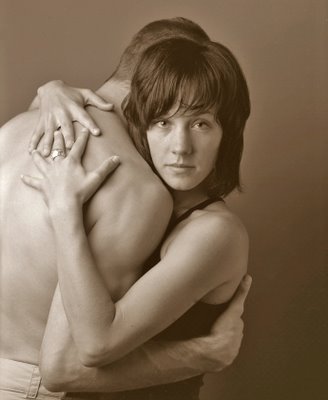
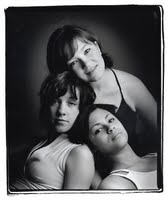
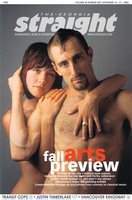
For many years I have thought of female ballet and modern dancers much in the same way as most other people do. They are are supposed to be slim, tall (or look tall) with slightly remote expressions that would suggest that at any given time they are channeling a white swan. This vision is difficult to sustain when one sees the voluptuous Cori Caulfield, the incredibly tall and muscular Emily Molnar and for those who thought that ballerinas never had cleavage, I still miss (as does Christopher Dafoe, the former Globe & Mail arts critic, turned lawyer) Ballet BC’s Gail Skrela.
I first noticed this revolution (a strong and compact one) when I saw Amber Funk for the first time. Funk even accentuated her short, muscular legs by dancing with work boots. With a smile on my face I watched Max Wyman’s puzzled look during a performance. He did not know what to make of this kind of dancer and of her dancing. I am positive that Funk has turned on many a young person to dance as many of the new breed of compact dancers have. A second compact dancer of note is Jennifer Clarke. In a shoot in my studio with Christopher Gaze she did not think twice about picking him up for the photo.
One compact dancer I did not get enough of is Sandrine Cassini (the perfect Ballet BC Carmen) who left town for Mannheim, Germany a couple of years ago. Fortunately I will see her on Saturday with my granddaughter Rebecca. She is in town dancing in the Alberta Ballet production of Romeo and Juliet.
There are two others that I first discovered a few years ago at Arts Umbrella where my Rebecca is on her third year of the dance program. Lina Fitzner is a gorgeous red-haired woman who is all curves. She taught my Rebecca when her other teacher, Andrea Hodge would go on a Ballet BC tour. I have seen her dance with Mascall Dance, with Amber Funk and in her own choreographed works. The other Arts Umbrella dancer I first saw four years ago at a year-end presentation of the school's dance program. She was a girl with sleepy eyes that smiled all the time.
It has been my pleasure to photograph Karissa Barry twice (once with Lina Fitzner and Amber Funk, Fitzner is top right and Funk bottom right) and most recently for this week's Georgia Straight cover with Farley Johansson. I told her (consider that it was a hot day and she was posing in a tiny bikini with Farley Johansson) that in the last century I would have seen her in a beach movie. She is that kind of girl- one you would have wanted to ask to the prom.
But when she dances, that’s another story.
Karissa Barry
Cruel To Be Kind
Thursday, September 14, 2006
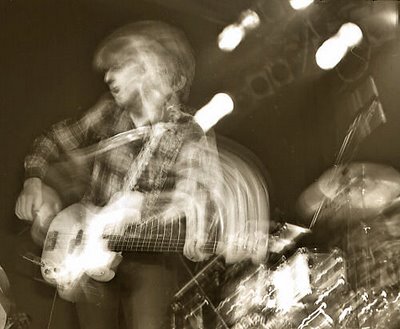
In mid November when I partially prune my roses and in March when I really go at them I hum along Nick Lowe's Cruel To Be Kind. It was in the late 70s, when Nick Lowe came to Vancouver with his band Rockpile, that I first saw him perform and I enjoyed his songs. I instantly liked Cruel To Be Kind even though I tried to ignore the lyrics which sounded a lot like S&M.
You've gotta be
Cruel to be kind in the right measure,
Cruel to be kind it's a very good sign,
Cruel to be kind means that I love you,
Baby, you've gotta be cruel to be kind...
But now I know that the song is the perfect song to prune roses by. In the past I have been reluctant to be as coldly vicious as Brad Jalbert (from Select Roses in Langley) taught me to be when pruning roses. And, every time, the roses did not perform as well. I learned my lesson and my roses have performed well after heavy pruning.
I am tempted to fertilize my roses in mid September. One thinks that after the wonderful display they gave me this year I should reward them with some food. But this is not so. If I fertilize them now they will grow and as soon as the early frosts hit Vancouver the new and tender growth will not be hardy and it will wither. Such kindness could even kill them. Nick Lowe is right.
The Lynch Mob
Wednesday, September 13, 2006
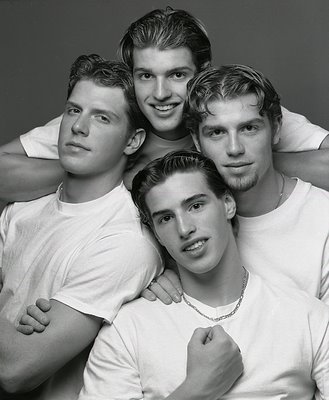
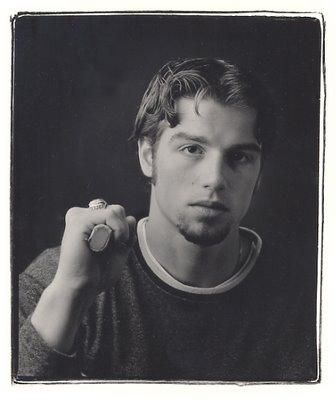
I have never understood hockey. Imagine me in Mexico City or Buenos Aires explaining the game.
You see, in this game if you hit someone hard with the hockey stick after pushing him into the boards they tell you, "You have been a nasty boy and you will not be allowed to play for 4 minutes." Then during the exciting moments of the game they have someone on a Hammond organ playing the Mexican Hat Dance.
In my first years in Vancouver, 30 years ago, I found myself watching the Montreal Canadiens while not understanding what the heck habitants meant. But somehow I could connect with Guy Lafleur's windswept long hair and I could almost imagine him as an Argentine centro delantero in a final between Boca and River Plate. It was my Hungarian/Canadian friend Paul Leisz, who took me to a game when I suddenly appreciated the game, in spite of that Hammond organ. The sounds of the game, the noise of the puck and the hits with the sticks were lost on TV. But what finally convinced me that this was a wonderful game was when Hockey Night In Canada and CBC cameraman supreme, Mike Varga took me into the CBC trailer outside the Coliseum to watch the director direct his cameramen on a huge multiple screen wall. That job has to be as exciting and stressful as that of a flight controller's.
In May 2002 I was called by Surrey's The Hockey Shop owner Rod Bolivar for a project dear to his heart. It seems that four brothers Lynch had been buying equipment at his shop for years and he felt he owed them something in return for their patronage. By some quirk of events all 4 brother were going to play professionally that year and 3 or 4 of them were going to play in a game together. Mr. Bolivar wanted me to take individual portraits of them and a group photo (above). I was immediately charmed by these handsome brothers who helped each other in the session. For the individual shots we played the game of showing a hockey stick, but not obviously, as seen here with the oldest brother Doug.
I was paid well but somehow the pleasure of the moment has remained in my memory long after I spent the money.
Lynch Mob
The Hockey Shop
Odd Pattern
Tuesday, September 12, 2006
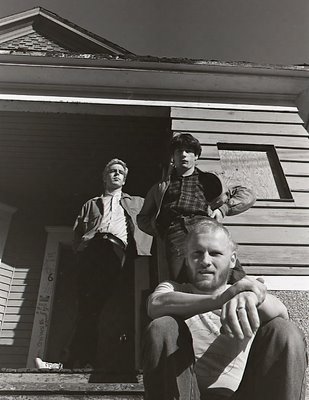

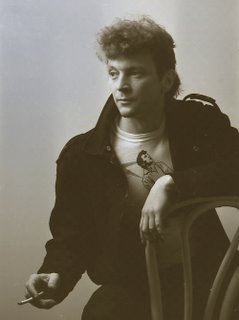
My photo files are arranged in alphabetical order so there are strange and disparate situations of people sharing space because of it. I have a separate section for writers and dancers. Consider the Cs in writers:
Charyn, Jerome
Christy, Jim
Cohen, Leonard
Coupland, Doug
But sometimes in the middle of the night I think of odder link patterns. There is one here:
1. Jim Bescott, the bass singer for my favourite Canadian band ever, Young Canadians ( Art Bergmann, left, Jim Bescott, centre and Barry Taylor).
2. Jean Lyons piano teacher and owner of Vancouver's oldest music school on 7th and Granville.
3. Britt Hagarty, who did lots of stuff including heroin. Here he posed during his Jean Vincent era in the early 80s in my Simpson Sears leather jacket. At the time he had written a biography on Jean Vincent called The Day the World Turned Blue.
All three were run over. Bescott died in a parking lot, Hagarty on the street and and Jean Lyons (84 and the last to die last year) was run over on Granville.
Hilary's Shadow
Monday, September 11, 2006
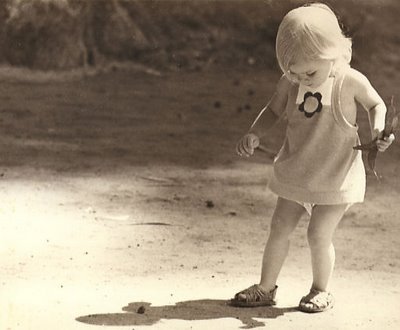
I remember even the smell of the eucalyptus trees on the Boulevard of the Bebederos near our home in Arboledas, Estado de México 32 years ago. That day has been poignant in my memory. We had gone for a walk with Ale, our eldest daugther and with Hilary who was 2. I saw this (note photograph) and watched as Hilary became aware for the first time that she had a shadow. She would move her foot to one side and the other. In fascination she watched her shadow follow every move. I sometimes wonder why it is that such decisive moments in our life are blurs that can only come back if a photograph proves it all happened. I despair that so many moments shared with Rebecca in Washington DC, in Argentina (in years past) will someday become lost shadows in her memory.
While I don't remember discovering my shadow I did have a road to Damascus moment inside my parent's armoire. I may have been 4 or 5 but I am not sure. My mother had brought a package of American candy corn. In Buenos Aires they were better than real gold nuggets. My mother rationed them a bunch at a time. Sometimes I tried to prolong the pleasure by eating one kernel at a time. Or I would push them all into my mouth for one flavour burst. It did not escape me that my mother would return the package to her large armoire, which had two mirrored doors. I decided I was going to have my fill of candy corn one afternoon when my mother was away teaching at school. I walked into the armoire (it was that big). I found the bag and began to have my fill when I suddenly spied my image on the mirror. I watched the little boy as I moved my arm this way and that way. It was then that I was filled with the understanding that the little boy was me.
Hilary's Shadow - A Postscript
I felt immediately guilty for going into my mother's private space. But such is the memory of that event that I have long forgotten the whipping I surely received when I was caught out.
Marilyn Chambers - Behind The Coach House Door
Sunday, September 10, 2006
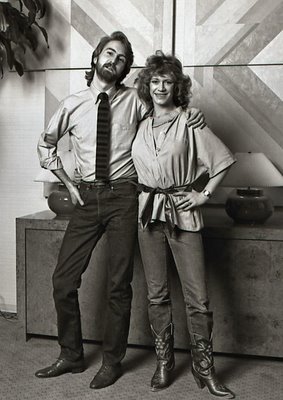
Sometime in the early 80s Les Wiseman and I went to the Four Seasons Hotel to photograph porn queen Marilyn Chambers. She was in town fronting a country and western band that was going to play at the Commodore. On the strength of her musical contribution to our city's culture, Wiseman was able to convince Vancouver Magazine Editor, Malcolm Parry, that Chambers was the genuine article. It was during my photo session with Chambers that I noticed her husband Chuck Traynor. It was this man that Linda Lovelace ( of Deep Throat fame) had acused of forcing her into making the film under gun point in her autobiography (written with Mike McGrady)Ordeal. It is the only time in my life that I have ever felt evil in a room.
Going down the elevator I asked Les if the star of the 1972 film Behind the Green Door really "did it". Les looked at me with an expression that seemed to say, "Alex how can you be so naive?"
It was about 10 years later that in one of my visits to Les Wiseman (when he was living in a coach house near city hall) that I experienced an event I will never forget. Les let me into the living room and said, "I want to show you something." He opened a TV cabinet and pushed in a VHS cassette into the recorder. Pointing at what I was watching he said, fast forwarding through 10 years, "See, Alex, they really do do it."
The Cat Lady Returns
Saturday, September 09, 2006
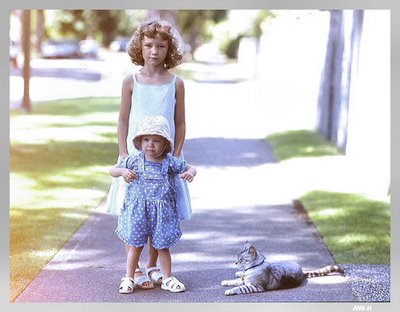
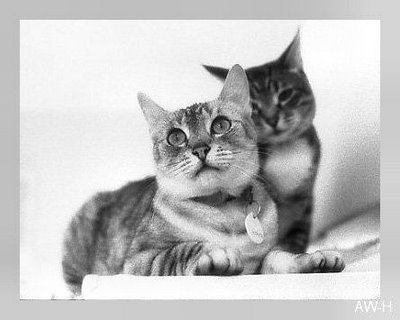
30 years ago, when we lived in a townhouse on Springer Avenue in Burnaby, our neighbour was a cat lady. She was a from Checkoslovakia. We were sure her husband (who would sneak bottles of wine into the house every day) was an alcoholic to escape his wife's madness for cats. After all, she baby talked to her couple of cats but shouted at him for this and that. We had a cat. We didn't talk to him much. We were ignorant of why cats spray and I vented my anger on the poor cat every time he would do something in our living room.
Now my wife Rosemary, baby talks to her cat Toby and my cat Plata. I am jealous. I just wish she would baby talk to me.
Our present cats are replacements to Polilla and Mosca who had a heart seizure on our bed while Rosemary was watching Hitchcock's Vertigo. I broke my spade burying him in the garden. I found Plata (her name was Cash so Plata is Argentine slang for cash) at the SPCA and brought her home. She looks like a miniature snow leopard to me. The quickest cure to the sorrow of a dead cat is an instant new one. But Polilla (moth), my white cat, did not take kindly to competition from another female. A few months later I found Polilla outside eviscerated by a Racoon. It was not a pretty sight. I broke another spade burying her. Niño, came as a replacement for Polilla but had a short life with us. He died of cancer. I had spotted Toby, who has perfect markings, at the SPCA when I brought Plata home. I returned and he was still there. Nobody wants a 14 year old cat. I came home empty handed. I returned with Rebecca (a mistake) who told me that unless we brought Toby home he was going to end his days in the cage. So Toby came home, even though his records warned us of his preference for jumping on horizontal surfaces in the house. His records did not tell us that also would push stuff from night tables (like the phone) to get us out of bed to feed him.
We have a harmonious household with two cats who love the garden. They sleep with us. Toby only drinks water from the bathroom sink tap. He insists on finishing my bowl of ice cream. Plata likes to walk around the block with us and with Rebecca and Lauren. People stare at us and look at my seriously when I tell them that Plata is a dog that just happens to be cat-like. Plata has a little orange cat who comes to visit her but Toby chases him away.
My oldest daughter bought me a heavy duty spade which I hope not to have to use to bury a cat for a long time.
Werner Herzog & The Italians
Friday, September 08, 2006
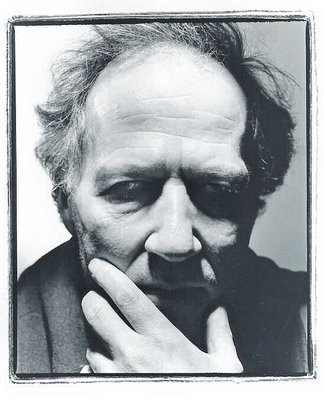
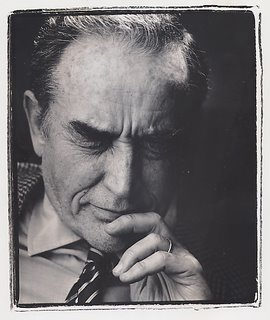
Werner Herzog (left) photographed in March 1996 at the now vanished Das Goethe-Institut, Vancouver
Incredible as it might sound the largest cultural presence in Vancouver is that of Italy through its wonderful Istituto Italiano di Cultura. You would think perhaps that it would be the Americans or even the English. I have gone to many fine concerts, lectures and exhibitions hosted by the Italians. I feel indebted to them for so much pleasure. My fave was when they brought Vittorio Gassman (upper right).
Instituto Italiano
Dana Before & During - Plus Triscuits For Kate
Thursday, September 07, 2006
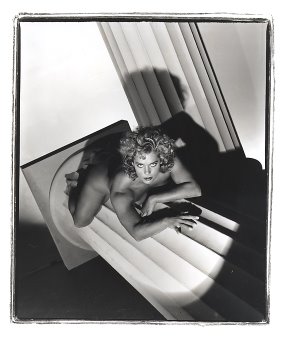
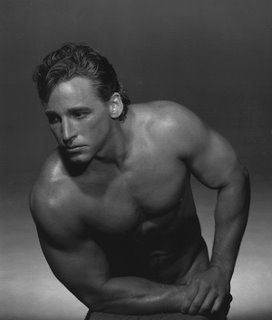
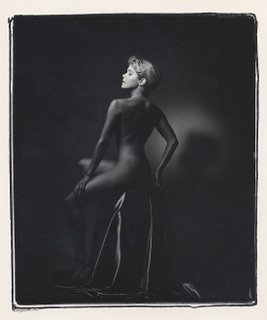
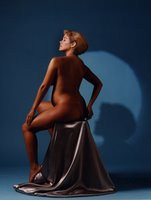
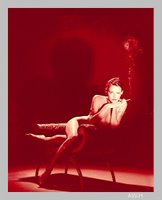
In September 1985, Vancouver Magazine editor Malcolm Parry assigned me to take pictures of 4 young women and one man who were interviewed by writer Les Wiseman on how they stayed thin and what were their diets. Four of the women made it to the October article called Hold It Right There. These were model Kate Davitt (in red), Pappas fur heiress Daphne Pappas, aerobics instructor Dana Zalko and Olympic Gym fitness instructor and bodybuilder Carla Temple (with Greek columns). Parry told me, "The less they wear the better." I told Zalko that Temple, her main competitor, was taking it all off so Zalko complied. I told Temple that Zalko was going to pose nude so she agreed, too. Model Davitt had no problem but Pappas and Temple's paramour, Mike Hamill, objected. Parry dropped Hamill (but seen here, top right) from the lineup and when the magazine considered how much money Pappas Furs spent in advertising with the magazine I was told to photograph Daphne Pappas with a fur coat. A few years later I was assigned to photograph a very pregnant Dana Zalko. We tried the diet photo but it was obvious that the same angle was not going to work so we did something else. Here you can see the rejected pose. Kate Davitt was a pleasure to photograph and I will never forget her daily regimen. For breakfast she sipped tea. For lunch and dinner she had Triscuits, cheese and apples. Nobody ever figured out (since it didn't run) that my photo of Mike Hamill was a rip off of George Hurrell's Johny Weismuller.
As a post script I read recently in the Vancouver Sun that the CBC was selling its Burnaby warehouse. I remember that warehouse fondly. Editor Parry, art director Chris Dahl, and writer Les Wiseman, all helped me man handle the "Greek" columns into a truck from there.
Seance - Neil Wedman
Wednesday, September 06, 2006

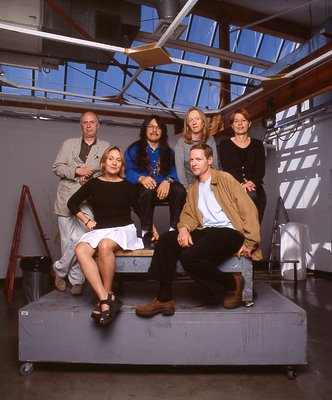
This group photo of Vancouver artists appeared in the Globe & Mail on May 15, 1999. From left to right you have:
Neil Wedman, Landon McKenzie(bottom left), Lawrence Yuxweluptun( middle top) Lucy Hogg (middle top right), Phillippe Raphanel (bottom right) and Renée van Halm.
Grant Simmons of DISC would drum scan my transparencies and he would send them (including this one) to the Globe photo desk with his high speed cable. At the time all I knew how to do was send emails! The reason this photograph (taken at Emily Carr Institute of Art & Design) is here now is that I need an excuse to also show Neil Wedman's Seance, 1990 a pencil sketch for his Equinox Gallery show Seance in 1992. The lovely sketch is in my living room to the left of my computer monitor. I see it every day and I have to smile.
Neil Wedman-Equinox Gallery
Neil Wedman
Blaze In September
Tuesday, September 05, 2006
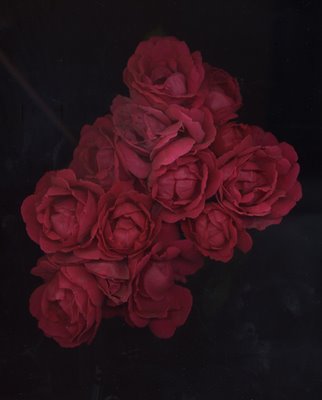
Mrs Young bought our house in 1954. I can see her going to local nurseries and buying plants to stock her garden. She had a heart attack in our kitchen in 1985 but survived; sold her house and moved to Ontario. Rosemary and I inherited her garden and for many years we tried to respect her choice of plants. We imagined that she was somehow a ghost in our garden. Whenever I would tell Harry Nomura (back in 1986 I thought I could afford a gardener) to do this, or that he would question me with a, "Mrs Young usually wanted me to do it this way."
Little by little her presence became less so and we started putting in our own plants. In 1954 Mrs Young did not have the choice of species rhododendrons with fragrant flowers (except for the lovely Rhododendron luteum she planted and I so love) so she planted what was hot then. And hot pinks and reds were hot. We have a few of those left. I removed most of her hybrid teas except for white Rosa 'Honour', I just can't pull the plug on her.
I now understand that all this had to be and that we lived the transition that was Mrs. Young's garden which we then had to make our own. In our back lane garden Mrs Young planted four climbing Rosa 'Blaze'. In 1954 it was one of the few disease free red climbers in the market. Blaze is supposed to be moderately fragrant. In our garden it isn't. I replaced three of the four Blaze with Rosa 'Madame Hardy', Rosa 'Climbing Ophelia', Rosa 'Charles de Mills', and Rosa 'Ayreshire Queen'. All of them are very fragrant and people who walk their dogs on our lane often comment on it.
Today I looked into the lane and few of my roses were in bloom, with the heat and the drought. But not Blaze. She was in bloom. It seems that for now she gets another reprieve. Mrs Young must be smiling somewhere.
Dal Richards, Woody & Woodie
Monday, September 04, 2006
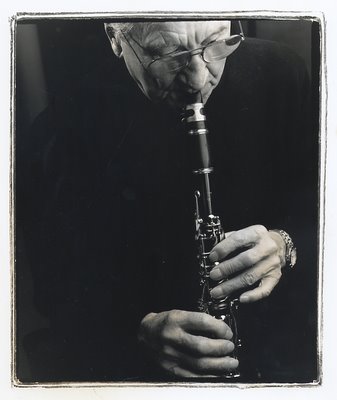
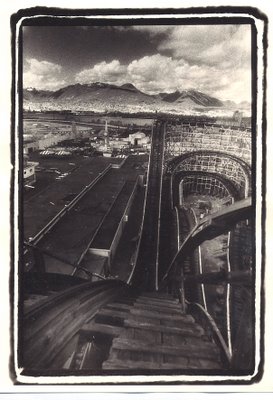
Rebecca is sad because she starts school tomorrow. PNE's waning days and the beginning of school seem to go hand in hand. I read a few weeks ago that Dal Richards was going to play at the PNE. I run into Mr. Richards (88) all the time (even at the opera) and he is always exquisitely dressed. He may be as elegant as Arthur Erickson (83). When I photographed Mr. Richards in December of 97, I asked him if the sax was his only instrument. He was delighted I had asked and he proudly showed me his clarinet.
It didn't take me long today to go from Dal Richard's clarinet, to Woody Herman, who played one and from there to another woodie, the 48-year-old roller coaster at the PNE.
Topper
Sunday, September 03, 2006
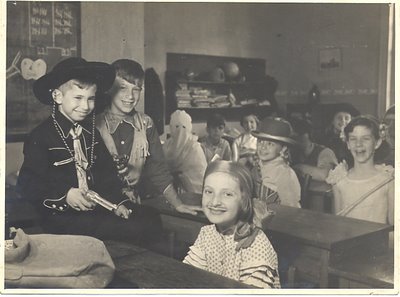
A few days ago my friend Paul Leisz and I were playing the horse name game. I thought I was ahead until Paul said, "Hopalong Cassidy's horse?" I just could not remember. I had to do, what all do, now, in the 21st century. I Googled Hopalong Cassidy.
I can safely say that the United States is here to stay because Americans have a language with the advantage that any word can be converted into a transitive verb. In Spanish we have many limitations. The verb roer (what a rodent does, chew or gnaw) in Spanish cannot be conjugated in the present tense, first person since, "I gnaw," would make me a rat or a mouse which I am not. So the Real Academia Española calls this a deffective verb, a verbo defectivo. It is almost impossible to translate into Spanish, "I was rear ended."
I think about Americans with affection. I had contact with them at an early age even though I was in Argentina. Consider that back in 1952 I was wearing a Hopalong Cassidy costume that had been given to me as a birthday gift, complete with the awesome cap gun. The happy young lady on the far right is Susan Stone. Her father was the general manager for General Motors in Latin America. Susan Stone often sent her father's Cadillac to pick me up at home so that we could play in her garden. My street friends could not figure out what Susan saw in me and neither did I. At 10 I was too naive to realize the benefits I had in going to an American school. It was at Susan's that I first saw a documentary showing oil derricks in Texas. I saw it on my first ever TV set. In 1952 I had never held a phone in my hand. This was something I was not to do until 1955 in Mexico.
While I feel Argentine in some deep corner of my heart, and I speak Spanish, sometimes with a Mexican accent, I have an intellectual attachment to the idea that I am a Canadian. I love my "new" country even though I have been here 30 years. Only recently did I stop feeling like a tourist in Vancouver.
I cringe when I read about Bush's latest utterings and I grieve for their lonely role as the world's policemen. Back in 1952 men were good if they wore white hats and they were bad if they wore a black one. The exception to the rule was William Boyd on Topper. Inside my Argentine being I must share some allegiance and love for all things Americans. I thought about all this while watching on Thursday the exquisite 1958 Western No Name on the Bullet with Audie Murphy. He wore a black hat but his attitude was certainly that of a man with a gray one. He was an American I can understand, accept, love and almost like.
Red Wind
Saturday, September 02, 2006

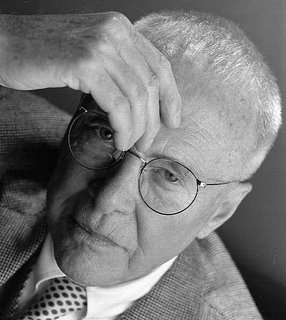
I have managed to see all but one of the movies featuring Raymond Chandler's Philip Marlowe. The one that I missed was the 1947 Brasher Doubloon with George Montgomery. Since I am a Raymond Chandler fan I even liked Robert Altman's 1973 The Long Goodbye with Elliot Gould. Gould seems to be stoned throughout. I am not sure if Raymond Chandler was ever satisfied with the actors that played his private detective in movies. I will never forget seeing a special TV interview with John Le Carré who when asked about Sir Alec Guinness playing George Smiley he answered something like this, "Alec, has taken Smiley away from me. I cannot write about Smiley without seeing Alec Guinness." By all accounts, no actor has ever gotten to the core, either in performance or in looks, to what Chandler fans expect. I thought that Robert Mitchum was close in the 1975 Farewell My Lovely but then I was distracted by my favourite actress, Charlotte Rampling so I didn't notice that Mitchum seemed a bit too old for the part.
In 1995 I had the opportunity to photograph Canadian artist Alex Colville. I asked him about my favourite painting, Pacific, 1967. I wanted to know why the painting has a ruler on the table. Colvile answered, "That was my mother's milliner's table."
I have only recently realized that in Pacific Colville depicts the perfect Philip Marlowe even if we only see him from behind. Even though most of us know that Marlowe usually packed a Luger.
Try looking at Pacific while listening to Pat Metheny's Red Wind in the ultimate Raymond Chandler jazz CD, Charlie Haden Quartet West - In Angel City. Any CD that quotes a long passage from Chandler's The Little Sister has to have something going for it. This CD has it in spades. Verve 837 031-2
Eros In A Brush
Friday, September 01, 2006
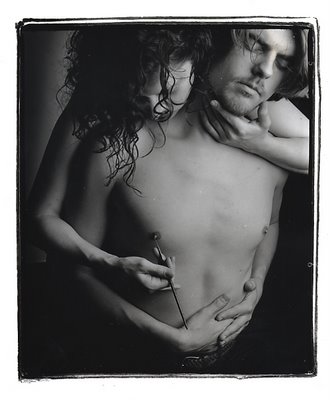
Being a freelance photographer can be tough in some of those months when you think the phone is never going to ring again. It is then when I think that perhaps I should have learned a more lucrative profession like plumbing or cabinet making with a minor in French polish. I wouldn't be able to take pictures like this one by saying to a beautiful woman, "I would like you to watch me install some of my best plumbing in Mrs Smith's kitchen. I think you are beautiful." On the other hand, as a photographer, I was able to approach Kimberly Klass (seen here) and take a series of photographs that explored my interest in eros. She called me one day to tell me that she had a new boy friend who was an artist. It didn't take me long to figure out a series of photographs that explored the use of a simple paint brush.






